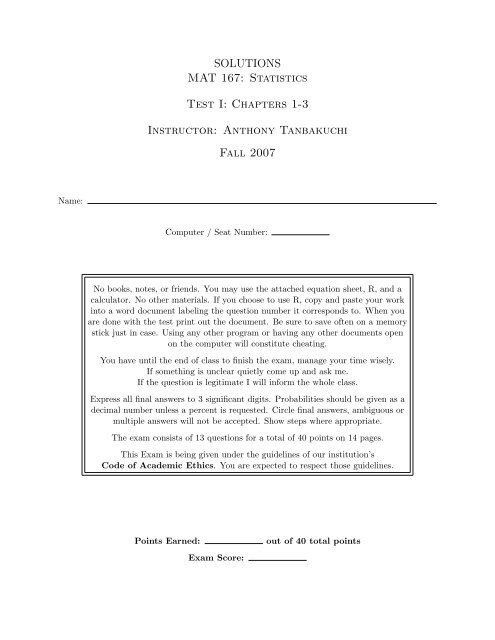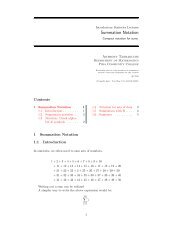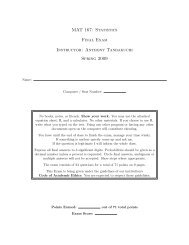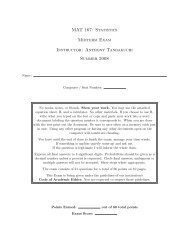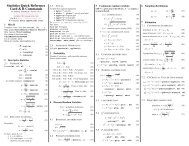SOLUTIONS MAT 167: Statistics Test I - Anthony Tanbakuchi
SOLUTIONS MAT 167: Statistics Test I - Anthony Tanbakuchi
SOLUTIONS MAT 167: Statistics Test I - Anthony Tanbakuchi
Create successful ePaper yourself
Turn your PDF publications into a flip-book with our unique Google optimized e-Paper software.
Name:<br />
<strong>SOLUTIONS</strong><br />
<strong>MAT</strong> <strong>167</strong>: <strong>Statistics</strong><br />
<strong>Test</strong> I: Chapters 1-3<br />
Instructor: <strong>Anthony</strong> <strong>Tanbakuchi</strong><br />
Fall 2007<br />
Computer / Seat Number:<br />
No books, notes, or friends. You may use the attached equation sheet, R, and a<br />
calculator. No other materials. If you choose to use R, copy and paste your work<br />
into a word document labeling the question number it corresponds to. When you<br />
are done with the test print out the document. Be sure to save often on a memory<br />
stick just in case. Using any other program or having any other documents open<br />
on the computer will constitute cheating.<br />
You have until the end of class to finish the exam, manage your time wisely.<br />
If something is unclear quietly come up and ask me.<br />
If the question is legitimate I will inform the whole class.<br />
Express all final answers to 3 significant digits. Probabilities should be given as a<br />
decimal number unless a percent is requested. Circle final answers, ambiguous or<br />
multiple answers will not be accepted. Show steps where appropriate.<br />
The exam consists of 13 questions for a total of 40 points on 14 pages.<br />
This Exam is being given under the guidelines of our institution’s<br />
Code of Academic Ethics. You are expected to respect those guidelines.<br />
Points Earned: out of 40 total points<br />
Exam Score:
<strong>MAT</strong> <strong>167</strong>: <strong>Statistics</strong>, <strong>Test</strong> I: Chapters 1-3 <strong>SOLUTIONS</strong> p. 1 of 14<br />
1. Given the following data collected from a random sample of individual’s heights in cm:<br />
170 185 155 168 162 164 280<br />
(a) (3 points) If you were asked to calculate the “average” height for this data, what measure<br />
of center (mean, median, mode, midrange) would you use? Give a clear reason why you<br />
choose this measure in terms of the data and what the measure represents.<br />
Solution: Since this data set contains an outlier, using a measure of center that is<br />
resistant to outliers would give a better representation of the “average” height. Recall<br />
that the term “average” is non-specific, and all the measures of center are different<br />
types of averages. The most resistant measure of center would be the mode, but this<br />
is primarily for categorical data. Therefore, the median would be the correct choice<br />
for quantitative continuous data.<br />
(b) (2 points) Compute the measure of center you recommended above for the data.<br />
Solution: Depending on your answer above you should have gotten one of the following:<br />
Median 168<br />
Mean 183<br />
Mode No mode for this data.<br />
(c) (2 points) Using the Range Rule of Thumb, estimate the standard deviation for the data.<br />
Solution:<br />
> x<br />
[ 1 ] 170 185 155 168 162 164 280<br />
> s . approx = (max( x ) − min ( x ))/4<br />
> s i g n i f ( s . approx , 3)<br />
[ 1 ] 3 1 .2<br />
(d) (2 points) Compute the standard deviation for the data.<br />
Solution: You should compute the sample standard deviation:<br />
> s = sd ( x )<br />
> s i g n i f ( s , 3)<br />
[ 1 ] 4 3 .6<br />
Instructor: <strong>Anthony</strong> <strong>Tanbakuchi</strong> Points earned: / 9 points
<strong>MAT</strong> <strong>167</strong>: <strong>Statistics</strong>, <strong>Test</strong> I: Chapters 1-3 <strong>SOLUTIONS</strong> p. 2 of 14<br />
2. A certain type of mouse has a mean weight of 500g and a standard deviation of 30g.<br />
(a) (2 points) Construct an interval using the Empirical Rule which you would expect 95% of<br />
the weights to fall within.<br />
Solution: The Empirical Rule states that 95% of the data falls within µ ± 2σ. Therefore<br />
we would expect the data to fall within:<br />
> s = 30<br />
> mu = 500<br />
> lower = mu − 2 ∗ s<br />
> upper = mu + 2 ∗ s<br />
> range . 9 5 = c ( lower , upper )<br />
> s i g n i f ( range . 9 5 , 3)<br />
[ 1 ] 440 560<br />
(b) (2 points) Find the z-score for a mouse with a weight of 445g.<br />
Solution:<br />
> x = 445<br />
> z = ( x − mu)/ s<br />
> s i g n i f ( z , 3)<br />
[ 1 ] −1.83<br />
(c) (1 point) Would you consider a mouse with a weight of 445g unusual?<br />
Solution: No, since |z| � 2.<br />
3. (2 points) “38% of adults in the United States regularly visit a doctor”. This conclusion was<br />
reached by a college student after she had questioned 520 randomly selected members of her<br />
college. What is wrong with her survey?<br />
Solution: Here survey is only representative of students at her college but she is making<br />
conclusions about the US population. To make such conclusions she would need to randomly<br />
sample the whole US population, not just the students on her campus.<br />
4. (2 points) Give an example of sampling error.<br />
Solution: Sampling errors are errors caused by chance fluctuations. An example would<br />
be randomly sampling 10 people and computing their mean height. If you performed this<br />
random sample multiple times you would find that the mean height would vary somewhat<br />
from sample to sample. Sampling error is the natural fluctuation due to sampling, it is not<br />
a human error or misuse of statistics as a non-sapling error would be.<br />
Instructor: <strong>Anthony</strong> <strong>Tanbakuchi</strong> Points earned: / 9 points
<strong>MAT</strong> <strong>167</strong>: <strong>Statistics</strong>, <strong>Test</strong> I: Chapters 1-3 <strong>SOLUTIONS</strong> p. 3 of 14<br />
5. (1 point) If the mean, median, and mode for a data set are all the same, what can you conclude<br />
about the data?<br />
Solution: If all three measures of center are the same, the data is symmetrical with no<br />
outliers.<br />
6. (2 points) Find 10C7.<br />
Solution: Using the combinations equation with n = 10, and r = 7:<br />
> f a c t o r i a l ( 1 0 ) / ( f a c t o r i a l (10 − 7) ∗ f a c t o r i a l ( 7 ) )<br />
[ 1 ] 120<br />
Instructor: <strong>Anthony</strong> <strong>Tanbakuchi</strong> Points earned: / 3 points
<strong>MAT</strong> <strong>167</strong>: <strong>Statistics</strong>, <strong>Test</strong> I: Chapters 1-3 <strong>SOLUTIONS</strong> p. 4 of 14<br />
7. The following is a modified box plot of final exam scores for two different sections of a statistics<br />
class taking the same exam.<br />
Final Exam Score<br />
50 60 70 80 90 100<br />
●<br />
section.1 section.2<br />
(a) (1 point) Which section had the highest score on the exam? Give an approximate value<br />
for the highest score.<br />
Solution: Section 2, highest score was approximately 98.<br />
(b) (1 point) Which section had the higher median score? Give the approximate median score<br />
for that section.<br />
Solution: Section 1 had the higher median score of approximately 75.<br />
(c) (1 point) A useful measure of variation is the inter-quartile range which is calculated as<br />
IQR = Q3 − Q1. Find the approximate IQR for section 2.<br />
Solution: For section 2 the approximate values for Q1 and Q3 are:<br />
> Q1 = 65<br />
> Q3 = 80<br />
> IQR = Q3 − Q1<br />
> IQR<br />
[ 1 ] 15<br />
(d) (1 point) What percent of data lies within the IQR?<br />
Solution: Between the first and third quarter is 50% of the data since the quarters<br />
break the data into four equal parts.<br />
8. (2 points) What is the probability of randomly selecting three people all born on the same day<br />
of the year? (Ignore leap years).<br />
Instructor: <strong>Anthony</strong> <strong>Tanbakuchi</strong> Points earned: / 6 points
<strong>MAT</strong> <strong>167</strong>: <strong>Statistics</strong>, <strong>Test</strong> I: Chapters 1-3 <strong>SOLUTIONS</strong> p. 5 of 14<br />
Solution: Conceptually, we are happy with any birthday for the first person, for the second<br />
two they must have the same birthday as the first (a 1 in 365 chance).<br />
> p = (365/365) ∗ (1/365) ∗ (1/365)<br />
> s i g n i f (p , 3)<br />
[ 1 ] 7 .51 e−06<br />
9. If a couple has 5 children, what is the probability that:<br />
(a) (1 point) They have exactly 2 girls and 3 boys (in that order).<br />
Solution:<br />
P (boy and boy and girl and girl and girl) and the probability of a boy or a girl is 0.5.<br />
> p = 0 . 5 ∗ 0 . 5 ∗ 0 . 5 ∗ 0 . 5 ∗ 0 . 5<br />
> p = 0.5ˆ5<br />
> s i g n i f (p , 3)<br />
[ 1 ] 0.0312<br />
(b) (2 points) They have at least one boy.<br />
Solution: Easier to find compliment. . .<br />
P (at least one boy) = 1 − P (no boys), where no boys is having 5 girls:<br />
P (girl and girl and girl and girl and girl)<br />
> p = 1 − ( 0 . 5 ˆ 5 )<br />
> s i g n i f (p , 3)<br />
[ 1 ] 0.969<br />
10. (3 points) In a blood testing procedure, blood samples from 5 people are combined into one<br />
mixture. The mixture will only test negative if all the individual samples are negative. If the<br />
probability that an individual sample tests positive is 0.20, what is the probability that the<br />
mixture will test positive?<br />
Solution:<br />
The sample will test positive if 1 or 2 or 3 or 4 or 5 of the people are positive or, more<br />
concisely, one or more are positive. So, the easy way to find the probability that one ore<br />
more are positive is to use the compliment:<br />
P (1 or more positive) = 1 − P (all 5 are negative). The probability of a negative result is<br />
1 − 0.20 = 0.80.<br />
> p = 1 − ( 0 . 8 ) ˆ 5<br />
> s i g n i f (p , 3)<br />
[ 1 ] 0.672<br />
Instructor: <strong>Anthony</strong> <strong>Tanbakuchi</strong> Points earned: / 6 points
<strong>MAT</strong> <strong>167</strong>: <strong>Statistics</strong>, <strong>Test</strong> I: Chapters 1-3 <strong>SOLUTIONS</strong> p. 6 of 14<br />
11. (3 points) If a class consists of 12 freshmen and 8 sophomores, find the probability of randomly<br />
selecting three students in the following order: a sophomore then a sophomore then a freshman<br />
without replacement.<br />
Solution:<br />
P (sophomore and sophomore and freshman) these are dependent events so we need to carefully<br />
count the number available and total number for each trial.<br />
> p = (8/20) ∗ (7/19) ∗ (12/18)<br />
> s i g n i f (p , 3)<br />
[ 1 ] 0.0982<br />
12. (2 points) A cruise ship has 1000 people on it. Of the 1000 people, 25 are crew members. Find<br />
the probability of randomly selecting 10 people without replacement and none of them are crew<br />
members.<br />
Solution: Since n/N ≤ 0.05, we can easily approximate the probability using independent<br />
events rather than calculate out all 10 probabilities.<br />
P (10 non crew members) ≈ P (non crew member) 10<br />
> n = 10<br />
> N = 1000<br />
> n/N<br />
[ 1 ] 0 .01<br />
> p . non . crew = 1 − 25/N<br />
> p = p . non . crew ˆn<br />
> s i g n i f (p , 3)<br />
[ 1 ] 0.776<br />
If you choose to do it without the approximation (more work), then you would have had:<br />
975 974 973<br />
1000 999 998<br />
966 975!/965!<br />
· · · 991 = 1000!/990!<br />
> p = prod ( 9 7 5 : 9 6 6 / 1 0 0 0 : 9 9 1 )<br />
> s i g n i f (p , 3)<br />
[ 1 ] 0.775<br />
As you can see the two methods have very good agreement because our approximation is<br />
sufficiently accurate for n/N ≤ 0.05<br />
13. Given the following frequency table summarizing data from a study:<br />
age.years frequency<br />
0-9 5.00<br />
10-19 8.00<br />
20-29 12.00<br />
30-39 2.00<br />
Instructor: <strong>Anthony</strong> <strong>Tanbakuchi</strong> Points earned: / 5 points
<strong>MAT</strong> <strong>167</strong>: <strong>Statistics</strong>, <strong>Test</strong> I: Chapters 1-3 <strong>SOLUTIONS</strong> p. 7 of 14<br />
(a) (1 point) Construct a relative frequency table.<br />
Solution:<br />
age.years relative.frequency.percent<br />
0-9 18.52<br />
10-19 29.63<br />
20-29 44.44<br />
30-39 7.41<br />
(b) (1 point) What is the probability of randomly selecting someone from the study who is in<br />
the age range 10-29?<br />
Solution:<br />
> p = (8 + 12)/(5 + 8 + 12 + 2)<br />
> s i g n i f (p , 3)<br />
[ 1 ] 0.741<br />
Instructor: <strong>Anthony</strong> <strong>Tanbakuchi</strong> Points earned: / 2 points
<strong>MAT</strong>67 Exam 1 <strong>Tanbakuchi</strong><br />
Name___________________________________<br />
Select the best answer from the choices provided.<br />
MULTIPLE CHOICE. Choose the one alternative that best completes the statement or answers the question.<br />
Determine whether the given value is a statistic or a parameter.<br />
1) A health and fitness club surveys 40 randomly selected members and found that the average<br />
weight of those questioned is 157 lb.<br />
A) Parameter B) Statistic<br />
Determine which of the four levels of measurement (nominal, ordinal, interval, ratio) is most appropriate.<br />
2) Nationalities of survey respondents.<br />
2)<br />
A) Ratio B) Nominal C) Interval D) Ordinal<br />
Identify the number as either continuous or discrete.<br />
3) The number of stories in a Manhattan building is 22.<br />
A) Discrete B) Continuous<br />
Identify which of these types of sampling is used: random, stratified, systematic, cluster, convenience.<br />
4) A tax auditor selects every 1000th income tax return that is received.<br />
A) Convenience<br />
B) Random<br />
C) Systematic<br />
D) Cluster<br />
E) Stratified<br />
Solve the problem.<br />
5) On a test of 40 items, Ariel got 31 correct. What percent were correct?<br />
A) 129.032258% B) 77.5% C) 1.29032258% D) 0.775%<br />
1<br />
1)<br />
3)<br />
4)<br />
5)
A nurse measured the blood pressure of each person who visited her clinic. Following is a relative-frequency<br />
histogram for the systolic blood pressure readings for those people aged between 25 and 40. Use the histogram to<br />
answer the question. The blood pressure readings were given to the nearest whole number.<br />
6) Approximately what percentage of the people aged 25-40 had a systolic blood pressure reading<br />
between 110 and 139 inclusive?<br />
A) 89% B) 75% C) 39% D) 59%<br />
Determine which score corresponds to the higher relative position.<br />
7) Which score has the better relative position: a score of 51 on a test for which x = 48 and s = 5, a<br />
score of 5.8 on a test for which x = 4.8 and s = 0.7 or a score of 434.3 on a test for which x = 383<br />
and s = 57?<br />
A) A score of 434.3 B) A score of 5.8 C) A score of 51<br />
Find the mode(s) for the given sample data.<br />
8) 82, 39, 32, 39, 29, 82<br />
A) 39 B) 82 C) 82, 39 D) 50.5<br />
Find the original data from the stem-and-leaf plot.<br />
9)<br />
Stem Leaves<br />
52 2 6 7<br />
53 2 4 8<br />
54 1 7<br />
A) 522, 526, 527, 532, 534, 538, 541, 547 B) 54, 58, 59, 55, 57, 61, 55, 61<br />
C) 52267, 53248, 5417 D) 522, 526, 537, 532, 534, 538, 541, 557<br />
Find the range for the given data.<br />
10) To get the best deal on a microwave oven, Jeremy called six appliance stores and asked the cost<br />
of a specific model. The prices he was quoted are listed below:<br />
$120 $536 $227 $618 $422 $258<br />
Compute the range.<br />
A) $120 B) $31 C) $498 D) $536<br />
2<br />
6)<br />
7)<br />
8)<br />
9)<br />
10)
Solve the problem.<br />
11) If the standard deviation of a set of data is zero, what can you conclude about the set of values?<br />
A) The sum of the values is zero.<br />
B) All values are equal to zero.<br />
C) The sum of the deviations from the mean is zero.<br />
D) All values are identical.<br />
Use the empirical rule to solve the problem.<br />
12) At one college, GPA's are normally distributed with a mean of 2.8 and a standard deviation of<br />
0.6. What percentage of students at the college have a GPA between 2.2 and 3.4?<br />
A) 95.44% B) 99.74% C) 68.26% D) 84.13%<br />
Answer the question, considering an event to be "unusual" if its probability is less than or equal to 0.05.<br />
13) Assume that a study of 300 randomly selected school bus routes showed that 281 arrived on<br />
time. Is it "unusual" for a school bus to arrive late?<br />
A) Yes B) No<br />
Answer the question.<br />
14) Which of the following cannot be a probability?<br />
A) 1<br />
2<br />
B) 3<br />
5<br />
C) 5<br />
3<br />
D) 2<br />
3<br />
Estimate the probability of the event.<br />
15) In a certain class of students, there are 12 boys from Wilmette, 6 girls from Kenilworth, 9 girls<br />
from Wilmette, 7 boys from Glencoe, 5 boys from Kenilworth and 3 girls from Glenoce. If the<br />
teacher calls upon a student to answer a question, what is the probability that the student will be<br />
from Kenilworth?<br />
A) 0.333 B) 0.143 C) 0.262 D) 0.208<br />
Find the indicated probability.<br />
16) A bag contains 4 red marbles, 3 blue marbles, and 5 green marbles. If a marble is randomly<br />
selected from the bag, what is the probability that it is blue?<br />
A) 1<br />
9<br />
B) 1<br />
4<br />
C) 1<br />
5<br />
D) 1<br />
3<br />
17) A sample of 100 wood and 100 graphite tennis rackets are taken from the warehouse. If 14<br />
wood and 13 graphite are defective and one racket is randomly selected from the sample, find<br />
the probability that the racket is wood or defective.<br />
A) 0.565<br />
B) 0.57<br />
C) 0.135<br />
D) There is insufficient information to answer the question.<br />
3<br />
11)<br />
12)<br />
13)<br />
14)<br />
15)<br />
16)<br />
17)
18) The following table contains data from a study of two airlines which fly to Small Town, USA.<br />
Number of flights Number of flights<br />
which were on time which were late<br />
Podunk Airlines 33 6<br />
Upstate Airlines 43 5<br />
If one of the 87 flights is randomly selected, find the probability that the flight selected arrived<br />
on time given that it was an Upstate Airlines flight.<br />
A) 43<br />
87<br />
C) 11<br />
76<br />
B) 43<br />
48<br />
D) None of the above is correct.<br />
19) Based on meteorological records, the probability that it will snow in a certain town on January<br />
1st is 0.269. Find the probability that in a given year it will not snow on January 1st in that town.<br />
A) 0.368 B) 3.717 C) 0.731 D) 1.269<br />
Provide a written description of the complement of the given event.<br />
20) When several textbooks are returned from editing, none of the books are found to be errorless.<br />
A) At least one of the textbooks is errorless.<br />
B) None of the textbooks are errorless.<br />
C) All of the textbooks are errorless.<br />
4<br />
18)<br />
19)<br />
20)
Answer Key<br />
<strong>Test</strong>name: EXAM1MULTIPLECHOICE<br />
1) B<br />
2) B<br />
3) A<br />
4) C<br />
5) B<br />
6) B<br />
7) B<br />
8) C<br />
9) A<br />
10) C<br />
11) D<br />
12) C<br />
13) B<br />
14) C<br />
15) C<br />
16) B<br />
17) A<br />
18) B<br />
19) C<br />
20) A<br />
5
Introductory <strong>Statistics</strong><br />
Quick Reference & R Commands<br />
by <strong>Anthony</strong> <strong>Tanbakuchi</strong>. Version 1.1<br />
http://www.tanbakuchi.com<br />
ANTHONY@TANBAKUCHI·COM<br />
Get R at: http://www.r-project.org<br />
More R help & examples at:<br />
http://tanbakuchi.com/Resources/R_<strong>Statistics</strong>/RBasics.html<br />
R commands: bold text<br />
1 Misc R<br />
To make a vector / store data: x=c(x1, x2, ...)<br />
Get help on function: ?functionName<br />
Get column of data from table: tableName$columnName<br />
List all variables: ls()<br />
Delete all variables: rm(list=ls())<br />
2 Descriptive <strong>Statistics</strong><br />
2.1 NUMERICAL<br />
Let x=c(x1, x2, x3, ...)<br />
√ x = sqrt(x) (1)<br />
x n = x ∧ n (2)<br />
n = length(x) (3)<br />
T = table(x) (4)<br />
n<br />
total = ∑<br />
i=1<br />
xi = sum(x) (5)<br />
min = min(x) (6)<br />
max = max(x) (7)<br />
six number summary : summary(x) (8)<br />
µ = ∑xi<br />
= mean(x)<br />
N<br />
(9)<br />
¯x = ∑xi<br />
= mean(x)<br />
n<br />
(10)<br />
˜x = P50 = median(x)<br />
�<br />
(11)<br />
∑(xi − µ)<br />
σ =<br />
2<br />
N<br />
�<br />
(12)<br />
s =<br />
∑(xi − ¯x) 2<br />
= sd(x)<br />
n − 1<br />
(13)<br />
CV = σ s<br />
=<br />
¯µ ¯x<br />
(14)<br />
2.2 RELATIVE STANDING<br />
x − µ x − ¯x<br />
z = =<br />
σ s<br />
Percentiles<br />
(15)<br />
Pk = xi, (sorted x)<br />
i − 0.5<br />
k = · 100%<br />
n<br />
To find xi given Pk, i is:<br />
(16)<br />
1 : L = k<br />
· n (17)<br />
100%<br />
2 : if L is an integer: i = L + 0.5; otherwise i=L and round up.<br />
2.3 VISUAL<br />
All plots have optional arguments:<br />
main="" sets title<br />
xlab="", ylab="" sets x/y-axis label<br />
type="p" for point plot<br />
type="l" for line plot<br />
type="b" for both points and lines<br />
Ex: plot(x, y, type="b", main="My Plot")<br />
Histogram: hist(x)<br />
Stem & leaf: stem(x)<br />
Box plot: boxplot(x)<br />
Barplot: plot(T) (where T=table(x))<br />
Scatter plot: plot(x,y) (where x, y are ordered vectors)<br />
Time series plot: plot(t,y) (where t, y are ordered vectors)<br />
Graph function: curve(expr, xmin, xmax) plot expr involving x<br />
2.4 ASSESSING NORMALITY<br />
Q-Q plot: qqnorm(x); qqline(x)<br />
3 Probability<br />
Number of successes x with n possible outcomes.<br />
(Don’t double count!)<br />
4 Random Variables<br />
4.1 DISCRETE DISTRIBUTIONS<br />
P(xi) : probability distribution (28)<br />
E = µ = ∑xi · P(xi)<br />
�<br />
(29)<br />
σ = ∑(xi − µ) 2 · P(xi) (30)<br />
4.2 CONTINUOUS DISTRIBUTIONS<br />
CDF F(x) gives area to the left of x, F −1 (p) expects p is area to the left.<br />
f (x) : probability density<br />
Z ∞<br />
E = µ = x · f (x)dx<br />
(31)<br />
(32)<br />
−∞<br />
�Z ∞<br />
σ = (x − µ)<br />
−∞<br />
2 · f (x)dx (33)<br />
F(x) : cumulative prob. density (CDF) (34)<br />
F −1 (x) : inv. cumulative prob. density (35)<br />
F(x ′ Z x ′<br />
) = f (x)dx (36)<br />
−∞<br />
p = P(x < x ′ ) = F(x ′ ) (37)<br />
4.3 SAMPLING DISTRIBUTIONS<br />
x ′ = F −1 (p) (38)<br />
p = P(x > a) = 1 − F(a) (39)<br />
p = P(a < x < b) = F(b) − F(a) (40)<br />
µ ¯x = µ σ ¯x = σ √<br />
n<br />
�<br />
pq<br />
µ ˆp = p σ ˆp =<br />
n<br />
4.4 BINOMIAL DISTRIBUTION<br />
(41)<br />
(42)<br />
µ = n · p (43)<br />
P(A) = xA<br />
n<br />
P(Ā) = 1 − P(A)<br />
(18)<br />
(19)<br />
P(A or B) = P(A) + P(B) − P(A and B)<br />
P(A or B) = P(A) + P(B) if A,B mutually exclusive<br />
P(A and B) = P(A) · P(B|A)<br />
(20)<br />
(21)<br />
(22)<br />
P(A and B) = P(A) · P(B) if A,B independent (23)<br />
n! = n(n − 1)(n − 2)···2 · 1 = factorial(n)<br />
nPk =<br />
(24)<br />
n!<br />
σ =<br />
Perm. no elements alike<br />
(n − k)!<br />
(25)<br />
n!<br />
=<br />
Perm. n1 alike, . . .<br />
n1!n2!···nk!<br />
n!<br />
nCk = = choose(n,k)<br />
(n − k)!k!<br />
(26)<br />
(27)<br />
√ n · p · q<br />
P(x) = nCx p<br />
(44)<br />
x q (n−x) = dbinom(x, n, p) (45)<br />
4.5 POISSON DISTRIBUTION<br />
P(x) = µx · e−µ = dpois(x, µ)<br />
x!<br />
(46)<br />
4.6 NORMAL DISTRIBUTION<br />
1<br />
f (x) = √<br />
2πσ2 · e− 1 (x−µ)<br />
2<br />
2<br />
σ2 p = P(z < z<br />
(47)<br />
′ ) = F(z ′ ) = pnorm(z’) (48)<br />
z ′ = F −1 (p) = qnorm(p)<br />
p = P(x < x<br />
(49)<br />
′ ) = F(x ′ ) = pnorm(x’, mean=µ, sd=σ)<br />
x<br />
(50)<br />
′ = F −1 (p) = qnorm(p, mean=µ, sd=σ) (51)
4.7 t-DISTRIBUTION<br />
4.8 χ 2 -DISTRIBUTION<br />
p = P(t < t ′ ) = F(t ′ ) = pt(t’, df) (52)<br />
t ′ = F −1 (p) = qt(p, df) (53)<br />
p = P(χ 2 < χ 2′ ) = F(χ 2′ ) = pchisq(X 2 ’, df) (54)<br />
χ 2′ = F −1 6.2 1-SAMPLE MEAN (σ KNOWN)<br />
(p) = qchisq(p, df) (55) H0 : µ = µ0<br />
4.9 F-DISTRIBUTION<br />
p = P(F < F ′ ) = F(F ′ ) = pf(F’, df1, df2) (56)<br />
F ′ = F −1 (p) = qf(p, df1, df2) (57)<br />
5 Estimation<br />
5.1 CONFIDENCE INTERVALS<br />
proportion: ˆp ± E, E = z α/2 · σ ˆp (58)<br />
mean (σ known): ¯x ± E, E = z α/2 · σ ¯x (59)<br />
mean (σ unknown, use s): ¯x ± E, E = t α/2 · σ ¯x, d f = n − 1 (60)<br />
variance:<br />
5.2 CRITICAL VALUES<br />
(n − 1)s2<br />
χ2 < σ<br />
R<br />
2 (n − 1)s2<br />
<<br />
χ2 , d f = n − 1 (61)<br />
L<br />
z α/2 = P(z > α) = qnorm(1-alpha/2) (62)<br />
t α/2 = P(t > α) = qt(1-alpha/2, df) (63)<br />
χ 2 L = P(χ 2 < α) = qchisq(alpha/2, df) (64)<br />
χ 2 R = P(χ 2 > α) = qchisq(1-alpha/2, df) (65)<br />
5.3 REQUIRED SAMPLE SIZE<br />
� zα/2<br />
�2<br />
proportion: n = ˆp ˆq ( ˆp = ˆq = 0.5 if unknown) (66)<br />
E<br />
� �2 zα/2 · ˆσ<br />
mean: n =<br />
(67)<br />
E<br />
6 Hypothesis <strong>Test</strong>s<br />
alternative can be:<br />
"two.sided", "less", "greater"<br />
6.1 1-SAMPLE PROPORTION<br />
H0 : p = p0<br />
prop.test(x, n, p=p0, alternative="two.sided")<br />
ˆp − p0<br />
z = �<br />
p0q0/n<br />
¯x − µ0<br />
z =<br />
σ/ √ n<br />
6.3 1-SAMPLE MEAN (σ UNKNOWN)<br />
H0 : µ = µ0<br />
t.test(x, mu=µ0, alternative="two.sided")<br />
Where x is a vector of sample data.<br />
(68)<br />
(69)<br />
¯x − µ0<br />
t =<br />
s/ √ , d f = n − 1 (70)<br />
n


